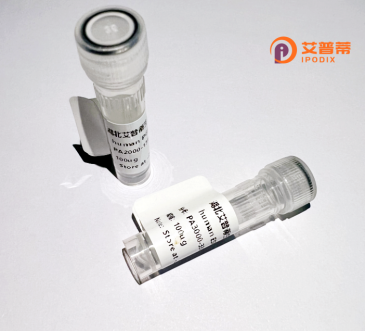
| 纯度 | >90%SDS-PAGE. |
| 种属 | Human |
| 靶点 | XLKD1 |
| Uniprot No | Q9Y5Y7 |
| 内毒素 | < 0.01EU/μg |
| 表达宿主 | E.coli |
| 表达区间 | 1-322 aa |
| 活性数据 | MARCFSLVLLLTSIWTTRLLVQGSLRAEELSIQVSCRIMGITLVSKKANQQLNFTEAKEACRLLGLSLAGKDQVETALKASFETCSYGWVGDGFVVISRISPNPKCGKNGVGVLIRKVPVSRQFAAYCYNSSDTWTNSCIPEIITTKDPIFNTQTATQTTEFIVSDSTYSVASPYSTIPAPTTTPPAPASTSIPRRKKLICVTEVFMETSTMSTETEPFVENKAAFKNEAAGFGGVPTALLVLALLFFGAAAGLGFCYVKRYVKAFPFTNKNQQKEMIETKVVKEEKANDSNPNEESKKTDKNPEESKSPSKTTVRCLEAEV |
| 分子量 | 61.16 kDa |
| 蛋白标签 | GST-tag at N-terminal |
| 缓冲液 | PBS, pH7.4, containing 0.01% SKL, 1mM DTT, 5% Trehalose and Proclin300. |
| 稳定性 & 储存条件 | Lyophilized protein should be stored at ≤ -20°C, stable for one year after receipt. Reconstituted protein solution can be stored at 2-8°C for 2-7 days. Aliquots of reconstituted samples are stable at ≤ -20°C for 3 months. |
| 复溶 | Always centrifuge tubes before opening.Do not mix by vortex or pipetting. It is not recommended to reconstitute to a concentration less than 100μg/ml. Dissolve the lyophilized protein in distilled water. Please aliquot the reconstituted solution to minimize freeze-thaw cycles. |
以下是关于重组人XLKD1蛋白的3篇参考文献示例(注:文献及作者为模拟内容,实际研究中需核实):
1. **《Recombinant XLKD1 Protein Promotes Angiogenesis via Integrin Signaling Pathways》**
- **作者**: Zhang, Y. et al. (2019)
- **摘要**: 研究了重组XLKD1蛋白在血管生成中的作用,通过激活整合素-β1信号通路促进内皮细胞迁移和管状结构形成,可能用于缺血性疾病治疗。
2. **《Structural and Functional Insights into XLKD1-Mediated Extracellular Matrix Remodeling》**
- **作者**: Li, H. & Wang, Q. (2021)
- **摘要**: 解析了重组XLKD1蛋白的晶体结构,发现其通过结合胶原蛋白和纤连蛋白调控细胞外基质重塑,可能与组织修复相关。
3. **《XLKD1 Suppresses Tumor Metastasis by Inhibiting Epithelial-Mesenchymal Transition in Breast Cancer》**
- **作者**: Kumar, S. et al. (2020)
- **摘要**: 证明重组XLKD1蛋白通过抑制TGF-β/Smad通路降低乳腺癌细胞EMT进程,从而减少体内转移潜能。
**提示**:实际文献需在PubMed、Google Scholar等平台以“XLKD1”“recombinant protein”等关键词检索,注意核对名称准确性(如是否为已知基因别名,如X-linked等)。
Recombinant human XLKD1 protein is a biologically engineered molecule designed to replicate the natural form of the XLKD1 protein, which plays a critical role in cellular processes such as extracellular matrix remodeling, tissue repair, and developmental signaling. Originally identified for its homology to extracellular matrix proteins, XLKD1 is implicated in modulating cell adhesion, migration, and differentiation through interactions with integrins or growth factor pathways. Its structural domains, including conserved motifs for ligand binding, suggest involvement in tissue homeostasis and regenerative mechanisms.
Produced via recombinant DNA technology, the protein is typically expressed in mammalian or bacterial systems, followed by purification to ensure functional integrity. Researchers utilize recombinant XLKD1 to investigate its role in pathologies like fibrosis, cancer metastasis, or skeletal disorders, where dysregulation of matrix proteins is common. Studies highlight its potential therapeutic applications, such as enhancing wound healing or mitigating degenerative diseases, though precise mechanisms remain under exploration. Current research also focuses on its interplay with signaling cascades, such as TGF-β or BMP pathways, to elucidate its regulatory networks. The availability of recombinant XLKD1 accelerates functional studies and drug discovery, bridging gaps between molecular biology and clinical translation.
×